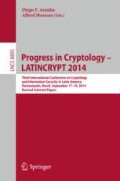Abstract
Homomorphic encryption allows computation on encrypted data at the cost of a significant loss in efficiency. In this paper we propose a powerful integer encoding for homomorphic encryption. The proposed encoding offers more efficient and convenient homomorphic computations on integers compared to previously used methods. This is possible by making the message space of the encryption scheme isomorphic to an integer quotient ring. The encoding can be used across various lattice-based homomorphic encryption schemes such as NTRU and various ring-LWE based schemes. We analyse the efficiency of our proposed encoding, which shows a significant gain compared to a naive integer encoding for a ring-LWE based scheme.
Access this chapter
Tax calculation will be finalised at checkout
Purchases are for personal use only
Notes
- 1.
We use the notation \([a_{i,j}]\) to represent a matrix of input values.
- 2.
We set \(p'=3\) for \(p=x-2\) because for \(a\in R\) it holds that \(\left\| [(x-2)*a]_R\right\| _\infty \le 3\cdot \left\| a\right\| _\infty \).
- 3.
Benchmarks were written in C++ using NTL, a library for doing number theory, and run on a machine with an Intel Core i5-2557M CPU and 4GB of RAM.
References
Asharov, G., Jain, A., Wichs, D.: Multiparty computation with low communication, computation and interaction via threshold FHE. Cryptology ePrint Archive, Report 2011/613 (2011). http://eprint.iacr.org/
Bos, J.W., Lauter, K., Loftus, J., Naehrig, M.: Improved security for a ring-based fully homomorphic encryption scheme. In: Stam, M. (ed.) IMACC 2013. LNCS, vol. 8308, pp. 45–64. Springer, Heidelberg (2013)
Brakerski, Z.: Fully homomorphic encryption without modulus switching from classical gapSVP. Cryptology ePrint Archive, Report 2012/078 (2012). http://eprint.iacr.org/
Brakerski, Z., Gentry, C., Vaikuntanathan, V.: (leveled) fully homomorphic encryption without bootstrapping. In: Proceedings of the 3rd Innovations in Theoretical Computer Science Conference, ITCS 2012, pp. 309–325. ACM, New York (2012)
Brakerski, Z., Vaikuntanathan, V.: Efficient fully homomorphic encryption from (standard) LWE. In: 2011 IEEE 52nd Annual Symposium on Foundations of Computer Science (FOCS), pp. 97–106 (2011)
Brakerski, Z., Vaikuntanathan, V.: Fully homomorphic encryption from ring-LWE and security for key dependent messages. In: Rogaway, P. (ed.) CRYPTO 2011. LNCS, vol. 6841, pp. 505–524. Springer, Heidelberg (2011)
Gentry, C.: A fully homomorphic encryption scheme. Ph.D. thesis, Stanford University (2009). crypto.stanford.edu/craig
Gentry, C., Goldman, K.A., Halevi, S., Julta, C., Raykova, M., Wichs, D.: Optimizing ORAM and using it efficiently for secure computation. In: De Cristofaro, E., Wright, M. (eds.) PETS 2013. LNCS, vol. 7981, pp. 1–18. Springer, Heidelberg (2013)
Gentry, C., Halevi, S., Smart, N.P.: Better bootstrapping in fully homomorphic encryption. In: Fischlin, M., Buchmann, J., Manulis, M. (eds.) PKC 2012. LNCS, vol. 7293, pp. 1–16. Springer, Heidelberg (2012)
Gentry, C., Halevi, S., Smart, N.P.: Homomorphic evaluation of the AES circuit. In: Safavi-Naini, R., Canetti, R. (eds.) CRYPTO 2012. LNCS, vol. 7417, pp. 850–867. Springer, Heidelberg (2012)
Graepel, T., Lauter, K., Naehrig, M.: ML confidential: Machine learning on encrypted data. Cryptology ePrint Archive, Report 2012/323 (2012). http://eprint.iacr.org/
Hoffstein, J., Pipher, J., Silverman, J.H.: NTRU: a ring-based public key cryptosystem. In: Buhler, J.P. (ed.) ANTS 1998. LNCS, vol. 1423, pp. 267–288. Springer, Heidelberg (1998)
Hoffstein, J., Silverman, J.: Optimizations for NTRU. In: Public-Key Cryptography and Computational Number Theory: Proceedings of the International Conference organized by the Stefan Banach International Mathematical Center Warsaw, Poland, September 11–15, 2000, p. 77. De Gruyter (2001)
Lauter, K., Naehrig, M., Vaikuntanathan, V.: Can homomorphic encryption be practical? In: Proceedings of the 3rd ACM Workshop on Cloud Computing Security Workshop, CCSW 2011, pp. 113–124. ACM, New York (2011). http://doi.acm.org/10.1145/2046660.2046682
Lindner, R., Peikert, C.: Better key sizes (and Attacks) for LWE-based encryption. In: Kiayias, A. (ed.) CT-RSA 2011. LNCS, vol. 6558, pp. 319–339. Springer, Heidelberg (2011)
López-Alt, A., Tromer, E., Vaikuntanathan, V.: On-the-fly multiparty computation on the cloud via multikey fully homomorphic encryption. In: Proceedings of the 44th Symposium on Theory of Computing, STOC 2012, pp. 1219–1234. ACM, New York (2012)
Lyubashevsky, V., Peikert, C., Regev, O.: On ideal lattices and learning with errors over rings. In: Gilbert, H. (ed.) EUROCRYPT 2010. LNCS, vol. 6110, pp. 1–23. Springer, Heidelberg (2010)
Micciancio, D., Regev, O.: Lattice-based cryptography. In: Bernstein, D.J., Buchmann, J., Dahmen, E. (eds.) Post-Quantum Cryptography, pp. 147–191. Springer, Heidelberg (2009)
Smart, N.P., Vercauteren, F.: Fully homomorphic encryption with relatively small key and ciphertext sizes. In: Nguyen, P.Q., Pointcheval, D. (eds.) PKC 2010. LNCS, vol. 6056, pp. 420–443. Springer, Heidelberg (2010)
Smart, N., Vercauteren, F.: Fully homomorphic SIMD operations. Cryptology ePrint Archive, Report 2011/133 (2011). http://eprint.iacr.org/
Stehlé, D., Steinfeld, R.: Faster fully homomorphic encryption. In: Abe, M. (ed.) ASIACRYPT 2010. LNCS, vol. 6477, pp. 377–394. Springer, Heidelberg (2010)
Author information
Authors and Affiliations
Corresponding author
Editor information
Editors and Affiliations
Rights and permissions
Copyright information
© 2015 Springer International Publishing Switzerland
About this paper
Cite this paper
Geihs, M., Cabarcas, D. (2015). Efficient Integer Encoding for Homomorphic Encryption via Ring Isomorphisms. In: Aranha, D., Menezes, A. (eds) Progress in Cryptology - LATINCRYPT 2014. LATINCRYPT 2014. Lecture Notes in Computer Science(), vol 8895. Springer, Cham. https://doi.org/10.1007/978-3-319-16295-9_3
Download citation
DOI: https://doi.org/10.1007/978-3-319-16295-9_3
Published:
Publisher Name: Springer, Cham
Print ISBN: 978-3-319-16294-2
Online ISBN: 978-3-319-16295-9
eBook Packages: Computer ScienceComputer Science (R0)

